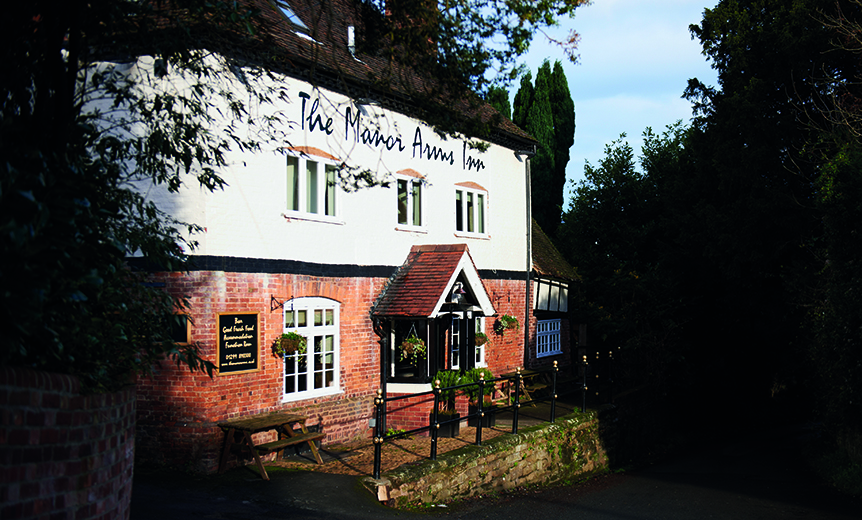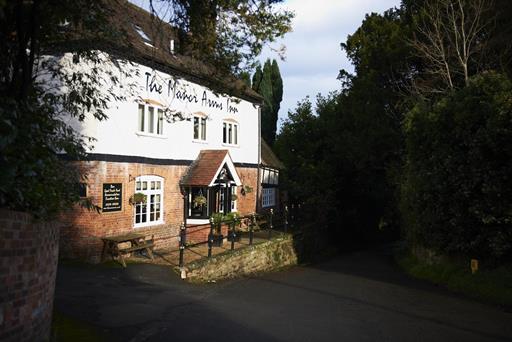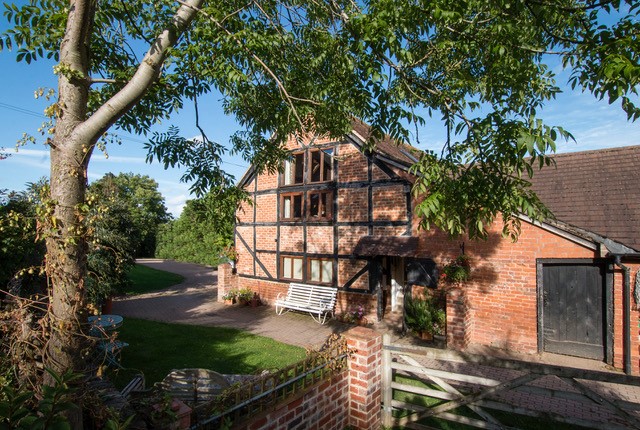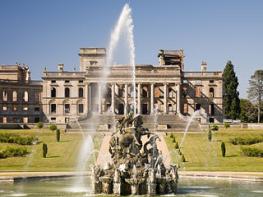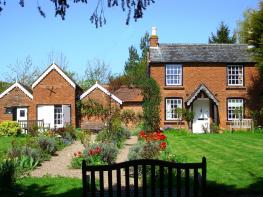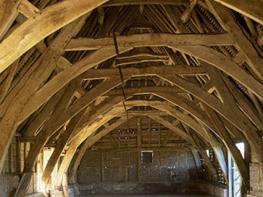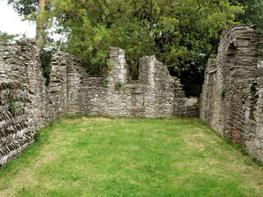Well off the beaten track Cider Mill Cottage feels gloriously isolated and enjoys stupendous…
Around Martley

7 miles (11.3kms)
About the walk
Don’t believe everything you read in your dictionary. The entry for ‘cyder’ could read ‘Same as cider’. The entry for ‘wine’ is scarcely less controversial: ‘The fermented juice of grapes; a liquor made from other fruits.’ If you can accept that grapes are not an essential ingredient of wine, then our ‘cyder’ is apple wine; if you can’t, then it’s fermented apple juice. Authentic, old-fashioned cyder is virtually extinct but some of the smaller manufacturers retain the old word, for example, Healey’s Cornish cyders, and from Suffolk, Aspall’s range including their 1728 Cyder with a dizzying 11 per cent alcohol by volume.
While being no real authority on drink, Mrs Beeton, writing in the inter-war edition of Mrs Beeton’s Family Cookery, gives a recipe for cider in which there are just two ingredients, cider apples and water, whereas the adjacent page has a recipe for apple wine, which has three ingredients: sugar, water and… cider. In other words, apple wine is ‘cider squared’ – a twice fermented-out cider. (By the way, the same publication suggests that one of your servants should clean the silver every Friday.) In the cyder-making process some water was added, because firstly a glutinous pulp was unworkable, and secondly even the hard-working enzymes of farm labourers would not maintain sobriety for (say) scything the corn when drinking copious quantities of a heady ferment.
Cyder was often a safer drink than water as the acids present in it killed off any water-borne diseases. In 1901, when making a critical assessment of the diet of the Dore Workhouse inmates, its medical officer wrote: ‘Cold water is a sickly thing to have to drink, especially for agricultural people used to cider.’ He may not have been implying that anything was wrong with the water, but his comment shows the ubiquitous nature of cider at that time.
Walk directions
Go up through the churchyard to the B4204. Cross to a rough track. In 100yds (91m) walk in trees, parallel to the school. Turn right into a field, then re-enter the grounds. Briefly follow the left edge of the playing fields, then a gate gives on to a field. At the road, turn left. Turn right, signposted ‘Highfields’. Beside Lingen Farm go down a track. At the bend take a stile to right, straight across the field. Cross a stream, then ascend, taking the right-hand gates. You will then reach a minor road.
Turn left. At Larkins go ahead, taking two stiles and a gate, then a field path, not the inviting parallel gravel track. Go ahead for two fields crossing two stiles and keeping straight ahead. Don’t move right, but pass close alongside a breeze-block barn and the driveway of a white bungalow, to walk behind Ross Green’s gardens, ignoring the obvious kissing gate to the left. Keep to left of fields to reach another road. Go straight over, to a partially broken, concealed stile, not diagonally to a prominent fingerpost. Walk beside a barn, then in the next field skirt left to another lane. Turn right for a few paces to a finger-post pointing into the apple orchard before the defiantly named Peartree Cottage.
Follow waymarkers carefully through this vast young orchard, descending gently. Cross a bridge over a ditch and pass over a stile, before continuing through more orchard. Emerge at a gate beside apple-sorting equipment. Go 200yds (183m) up this track, to a gap in evergreens. Turn left, down an orchard ride. At a T-junction turn right, up to just before a gate beside a small house. Turn left, almost back on yourself. Go very carefully through the orchard, following faded yellow splodges about 1.5ft (45cm) up on the tree trunks, but sometimes obscured by low branches. Leave by a footbridge, keeping to the left field, crossing to the B4197.
Turn right for 60yds (55m). Take an excellent track (mostly tarmac) for 0.5 mile (800m) to Rodge Hill’s top. Turn sharp left, ‘Worcestershire Way’. Follow this for 1 mile (1.6km). Steps lead down to a road’s hairpin bend.
Turn right. In 20yds (18m) turn left, but in only 15yds (14m) turn right again, into conifers. Emerge to drop down steeply. At the B4204 turn right for 30yds (27m). Use a permissive path across two fields to the River Teme. Follow this beautiful riverside walk, later in Kingswood Nature Reserve, for over 0.5 mile (800m). Leave the river when a wire fence requires it. Ascend a steep path, later a driveway, to a tarmac road.
Turn right, uphill; this soon bends left. Near the brow move right (waymarker) just to walk in the field, not on the road. At the tarmac junction turn left but, in 275yds (251m), walk beside a smart wire fence then pass through a gap between hedge and sheds to continue, before emerging between the former Crown pub and the garage. Cross the B4197 straight onto the B4204, then turn right to the church and the start of the walk.
Additional information
Field paths, lanes, orchard paths, tracks, river meadows, minor roads, several stiles
Arable, orchards, wooded ridges and Teme Valley
Off-lead opportunities if under control
OS Explorer 204 Worcester & Droitwich Spa
Just south of St Peter’s Church, Martley
None on route
WALKING IN SAFETY
Read our tips to look after yourself and the environment when following this walk.
Find out more
Also in the area
About the area
Discover Worcestershire
Worcestershire is a county of rolling hills, save for the flat Vale of Evesham in the east and the prominent spine of the Malverns in the west. Nearly all of the land is worked in some way; arable farming predominates – oilseed rape, cereals and potatoes – but there are concentrated areas of specific land uses, such as market gardening and plum growing.
Worcester is the county town, and home to Worcestershire County Cricket Club, which has what some regard as the most attractive grounds in the country, in a delightful setting with views of Worcester Cathedral. The Malverns, Great and Little, set on the slopes of the Malvern Hills, are renowned for their refinement. Great Malvern, terraced on its hillside site, came to prominence as a genteel spa for well-to-do Victorians, rivalling the likes of Bath, Buxton and Cheltenham with its glorious surroundings.
Sir Edward Elgar was a Worcester man, and his statue stands on the High Street, facing the cathedral. The cottage where he was born is now a museum and he is commemorated on the £20 note. Other notable Worcestershire figures include poet A E Housman, chocolate magnate George Cadbury; and Lea and Perrins, inventors of Worcestershire sauce.
Nearby stays
Restaurants and Pubs
Nearby experiences
Recommended things to do
Why choose Rated Trips?
Your trusted guide to rated places across the UK
The best coverage
Discover more than 15,000 professionally rated places to stay, eat and visit from across the UK and Ireland.
Quality assured
Choose a place to stay safe in the knowledge that it has been expertly assessed by trained assessors.
Plan your next trip
Search by location or the type of place you're visiting to find your next ideal holiday experience.
Travel inspiration
Read our articles, city guides and recommended things to do for inspiration. We're here to help you explore the UK.


